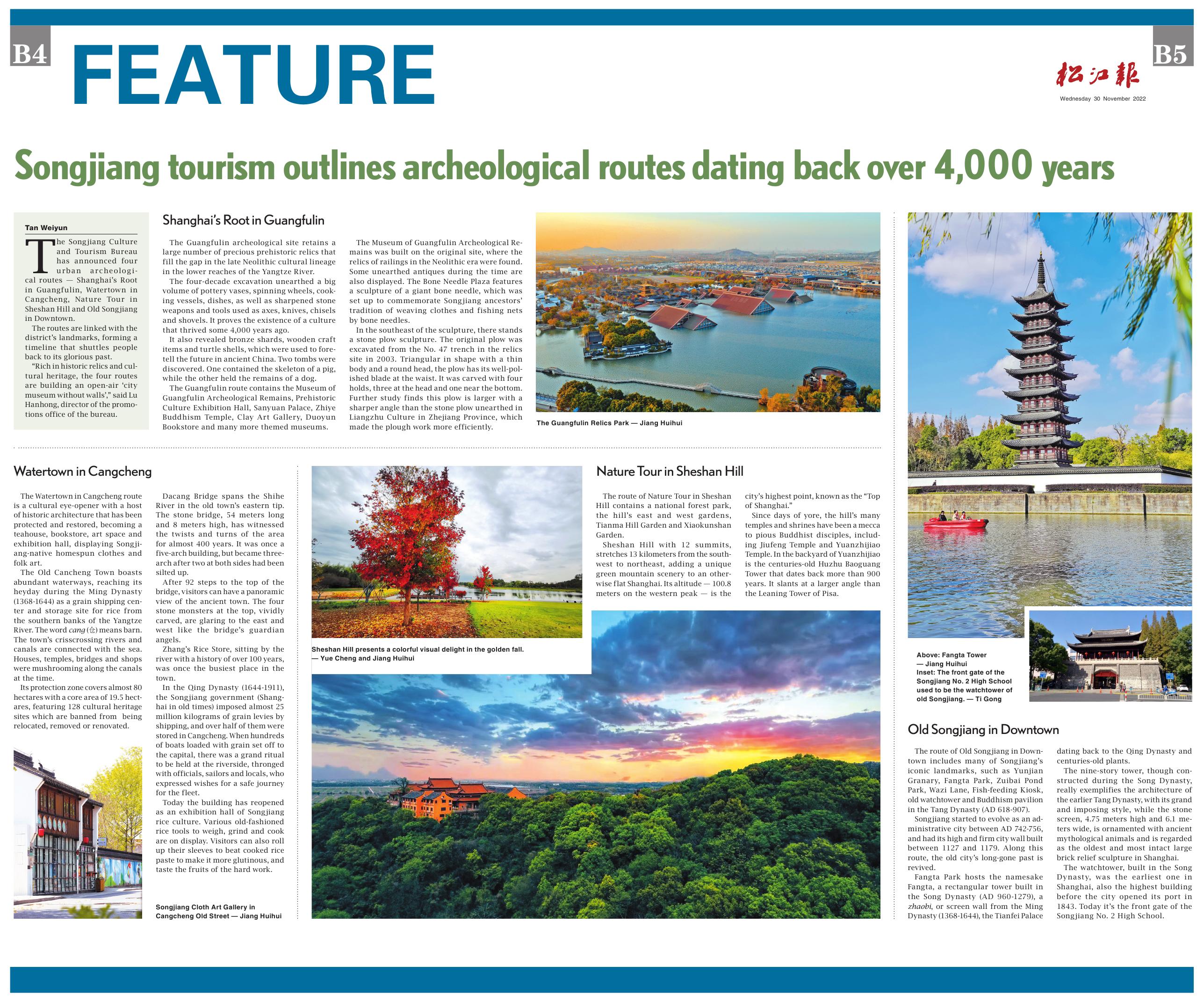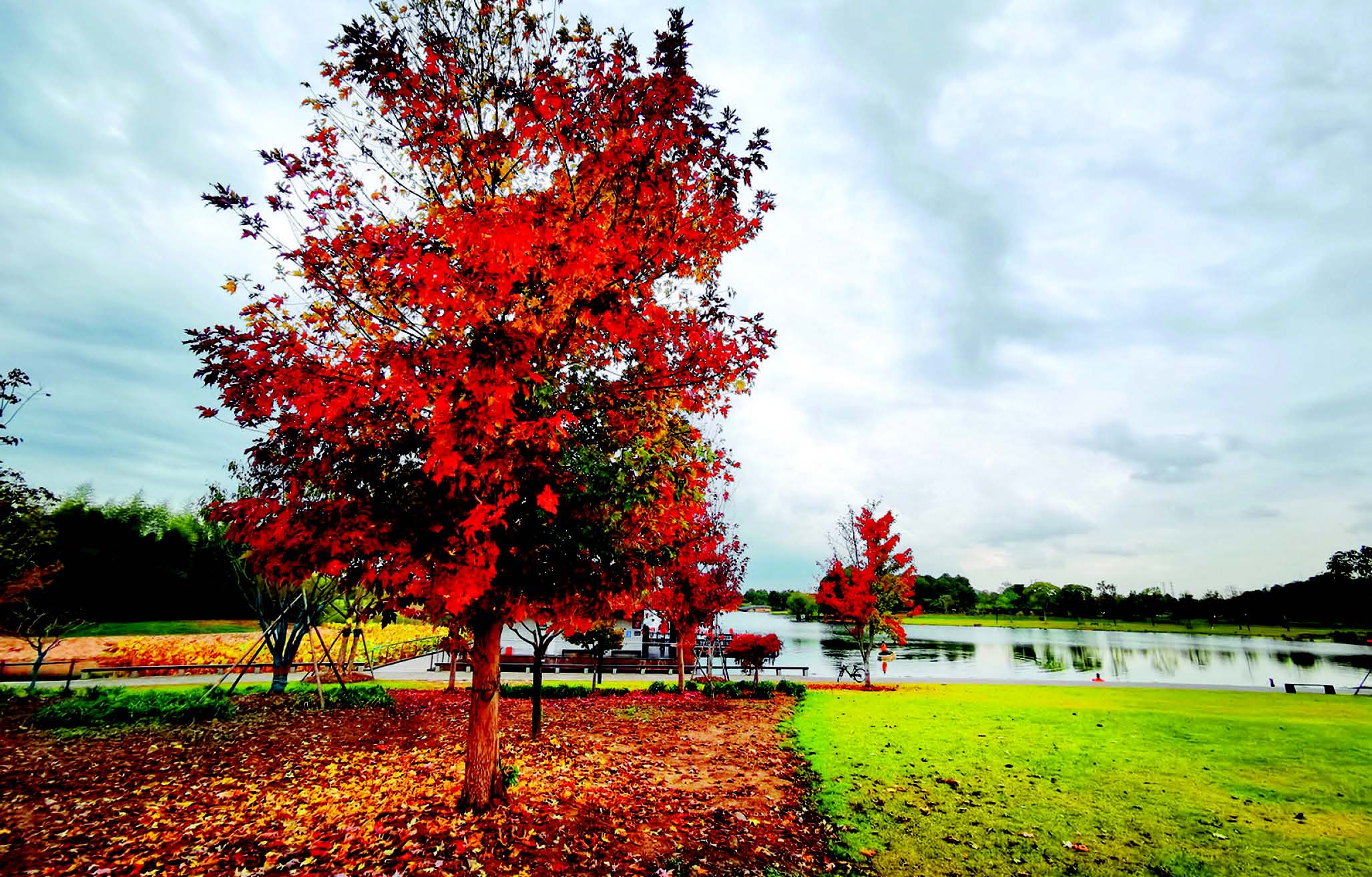

Songjiang tourism outlines archeological routes dating back over 4,000 years
Tan Weiyun
The Songjiang Culture and Tourism Bureau has announced four urban archeologi-cal routes — Shanghai’s Root in Guangfulin, Watertown in Cangcheng, Nature Tour in Sheshan Hill and Old Songjiang in Downtown.
The routes are linked with the district’s landmarks, forming a timeline that shuttles people back to its glorious past.
“Rich in historic relics and cul-tural heritage, the four routes are building an open-air ‘city museum without walls’,” said Lu Hanhong, director of the promo-tions office of the bureau.
Shanghai’s Root in Guangfulin
The Guangfulin archeological site retains a large number of precious prehistoric relics that fill the gap in the late Neolithic cultural lineage in the lower reaches of the Yangtze River.
The four-decade excavation unearthed a big volume of pottery vases, spinning wheels, cook-ing vessels, dishes, as well as sharpened stone weapons and tools used as axes, knives, chisels and shovels. It proves the existence of a culture that thrived some 4,000 years ago.
It also revealed bronze shards, wooden craft items and turtle shells, which were used to fore-tell the future in ancient China. Two tombs were discovered. One contained the skeleton of a pig, while the other held the remains of a dog.
The Guangfulin route contains the Museum of Guangfulin Archeological Remains, Prehistoric Culture Exhibition Hall, Sanyuan Palace, Zhiye Buddhism Temple, Clay Art Gallery, Duoyun Bookstore and many more themed museums.
The Museum of Guangfulin Archeological Re-mains was built on the original site, where the relics of railings in the Neolithic era were found. Some unearthed antiques during the time are also displayed. The Bone Needle Plaza features a sculpture of a giant bone needle, which was set up to commemorate Songjiang ancestors’ tradition of weaving clothes and fishing nets by bone needles.
In the southeast of the sculpture, there stands a stone plow sculpture. The original plow was excavated from the No. 47 trench in the relics site in 2003. Triangular in shape with a thin body and a round head, the plow has its well-pol-ished blade at the waist. It was carved with four holds, three at the head and one near the bottom. Further study finds this plow is larger with a sharper angle than the stone plow unearthed in Liangzhu Culture in Zhejiang Province, which made the plough work more efficiently.

The Guangfulin Relics Park — Jiang Huihui
Watertown in Cangcheng
The Watertown in Cangcheng route is a cultural eye-opener with a host of historic architecture that has been protected and restored, becoming a teahouse, bookstore, art space and exhibition hall, displaying Songji-ang-native homespun clothes and folk art.
The Old Cancheng Town boasts abundant waterways, reaching its heyday during the Ming Dynasty (1368-1644) as a grain shipping cen-ter and storage site for rice from the southern banks of the Yangtze River. The word cang (仓) means barn. The town’s crisscrossing rivers and canals are connected with the sea. Houses, temples, bridges and shops were mushrooming along the canals at the time.
Its protection zone covers almost 80 hectares with a core area of 19.5 hect-ares, featuring 128 cultural heritage sites which are banned from being relocated, removed or renovated.
Dacang Bridge spans the Shihe River in the old town’s eastern tip. The stone bridge, 54 meters long and 8 meters high, has witnessed the twists and turns of the area for almost 400 years. It was once a five-arch building, but became three- arch after two at both sides had been silted up.
After 92 steps to the top of the bridge, visitors can have a panoramic view of the ancient town. The four stone monsters at the top, vividly carved, are glaring to the east and west like the bridge’s guardian angels.
Zhang’s Rice Store, sitting by the river with a history of over 100 years, was once the busiest place in the town.
In the Qing Dynasty (1644-1911), the Songjiang government (Shang-hai in old times) imposed almost 25 million kilograms of grain levies by shipping, and over half of them were stored in Cangcheng. When hundreds of boats loaded with grain set off to the capital, there was a grand ritual to be held at the riverside, thronged with officials, sailors and locals, who expressed wishes for a safe journey for the fleet.
Today the building has reopened as an exhibition hall of Songjiang rice culture. Various old-fashioned rice tools to weigh, grind and cook are on display. Visitors can also roll up their sleeves to beat cooked rice paste to make it more glutinous, and taste the fruits of the hard work.

Songjiang Cloth Art Gallery in Cangcheng Old Street — Jiang Huihui
Nature Tour in Sheshan Hill
The route of Nature Tour in Sheshan Hill contains a national forest park, the hill’s east and west gardens, Tianma Hill Garden and Xiaokunshan Garden.
Sheshan Hill with 12 summits, stretches 13 kilometers from the south-west to northeast, adding a unique green mountain scenery to an other-wise flat Shanghai. Its altitude — 100.8 meters on the western peak — is the city’s highest point, known as the “Top of Shanghai.”
Since days of yore, the hill’s many temples and shrines have been a mecca to pious Buddhist disciples, includ-ing Jiufeng Temple and Yuanzhijiao Temple. In the backyard of Yuanzhijiao is the centuries-old Huzhu Baoguang Tower that dates back more than 900 years. It slants at a larger angle than the Leaning Tower of Pisa.


Sheshan Hill presents a colorful visual delight in the golden fall. — Yue Cheng and Jiang Huihui
Old Songjiang in Downtown


Above: Fangta Tower — Jiang Huihui
Inset: The front gate of the Songjiang No. 2 High School used to be the watchtower of old Songjiang. — Ti Gong
江苏路特数字科技有限公司 仅提供技术服务支持,文字、图片、视频版权归属发布媒体

